数据库简介 英文
- 格式:pdf
- 大小:111.32 KB
- 文档页数:8

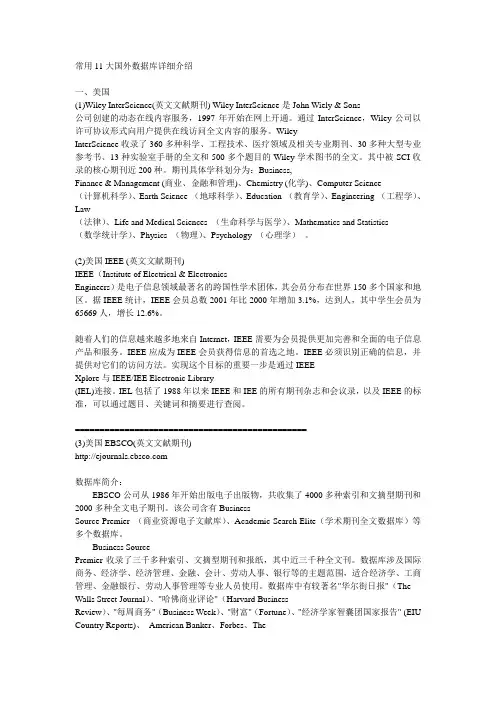
常用11大国外数据库详细介绍一、美国(1)Wiley InterScience(英文文献期刊) Wiley InterScience是John Wiely & Sons公司创建的动态在线内容服务,1997年开始在网上开通。
通过InterScience,Wiley公司以许可协议形式向用户提供在线访问全文内容的服务。
WileyInterScience收录了360多种科学、工程技术、医疗领域及相关专业期刊、30多种大型专业参考书、13种实验室手册的全文和500多个题目的Wiley学术图书的全文。
其中被SCI收录的核心期刊近200种。
期刊具体学科划分为:Business,Finance & Management (商业、金融和管理)、Chemistry (化学)、Computer Science(计算机科学)、Earth Science (地球科学)、Education (教育学)、Engineering (工程学)、Law(法律)、Life and Medical Sciences (生命科学与医学)、Mathematics and Statistics(数学统计学)、Physics (物理)、Psychology (心理学)。
(2)美国IEEE (英文文献期刊)IEEE(Institute of Electrical & ElectronicsEngineers)是电子信息领域最著名的跨国性学术团体,其会员分布在世界150多个国家和地区。
据IEEE统计,IEEE会员总数2001年比2000年增加3.1%,达到人,其中学生会员为65669人,增长12.6%。
随着人们的信息越来越多地来自Internet,IEEE需要为会员提供更加完善和全面的电子信息产品和服务。
IEEE应成为IEEE会员获得信息的首选之地。
IEEE必须识别正确的信息,并提供对它们的访问方法。
实现这个目标的重要一步是通过IEEEXplore与IEEE/IEE Electronic Library(IEL)连接。
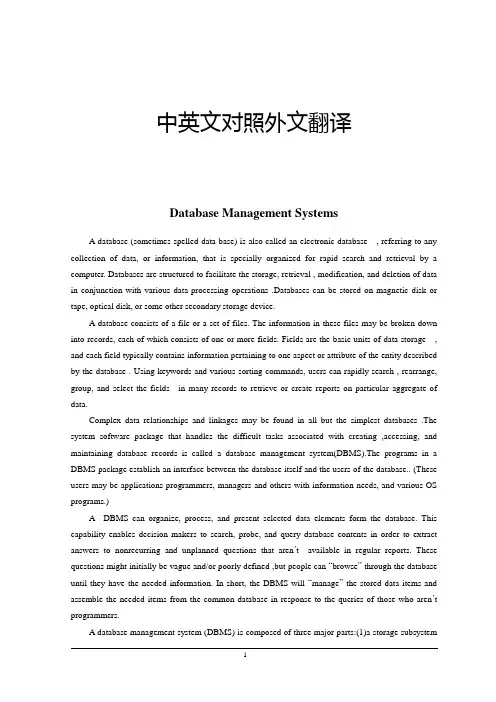
中英文对照外文翻译Database Management SystemsA database (sometimes spelled data base) is also called an electronic database , referring to any collection of data, or information, that is specially organized for rapid search and retrieval by a computer. Databases are structured to facilitate the storage, retrieval , modification, and deletion of data in conjunction with various data-processing operations .Databases can be stored on magnetic disk or tape, optical disk, or some other secondary storage device.A database consists of a file or a set of files. The information in these files may be broken down into records, each of which consists of one or more fields. Fields are the basic units of data storage , and each field typically contains information pertaining to one aspect or attribute of the entity described by the database . Using keywords and various sorting commands, users can rapidly search , rearrange, group, and select the fields in many records to retrieve or create reports on particular aggregate of data.Complex data relationships and linkages may be found in all but the simplest databases .The system software package that handles the difficult tasks associated with creating ,accessing, and maintaining database records is called a database management system(DBMS).The programs in a DBMS package establish an interface between the database itself and the users of the database.. (These users may be applications programmers, managers and others with information needs, and various OS programs.)A DBMS can organize, process, and present selected data elements form the database. This capability enables decision makers to search, probe, and query database contents in order to extract answers to nonrecurring and unplanned questions that aren’t available in regular reports. These questions might initially be vague and/or poorly defined ,but people can “browse” through the database until they have the needed information. In short, the DBMS will “manage” the stored data items and assemble the needed items from the common database in response to the queries of those who aren’t programmers.A database management system (DBMS) is composed of three major parts:(1)a storage subsystemthat stores and retrieves data in files;(2) a modeling and manipulation subsystem that provides the means with which to organize the data and to add , delete, maintain, and update the data;(3)and an interface between the DBMS and its users. Several major trends are emerging that enhance the value and usefulness of database management systems;Managers: who require more up-to-data information to make effective decisionCustomers: who demand increasingly sophisticated information services and more current information about the status of their orders, invoices, and accounts.Users: who find that they can develop custom applications with database systems in a fraction of the time it takes to use traditional programming languages.Organizations : that discover information has a strategic value; they utilize their database systems to gain an edge over their competitors.The Database ModelA data model describes a way to structure and manipulate the data in a database. The structural part of the model specifies how data should be represented(such as tree, tables, and so on ).The manipulative part of the model specifies the operation with which to add, delete, display, maintain, print, search, select, sort and update the data.Hierarchical ModelThe first database management systems used a hierarchical model-that is-they arranged records into a tree structure. Some records are root records and all others have unique parent records. The structure of the tree is designed to reflect the order in which the data will be used that is ,the record at the root of a tree will be accessed first, then records one level below the root ,and so on.The hierarchical model was developed because hierarchical relationships are commonly found in business applications. As you have known, an organization char often describes a hierarchical relationship: top management is at the highest level, middle management at lower levels, and operational employees at the lowest levels. Note that within a strict hierarchy, each level of management may have many employees or levels of employees beneath it, but each employee has only one manager. Hierarchical data are characterized by this one-to-many relationship among data.In the hierarchical approach, each relationship must be explicitly defined when the database is created. Each record in a hierarchical database can contain only one key field and only one relationship is allowed between any two fields. This can create a problem because data do not always conform to such a strict hierarchy.Relational ModelA major breakthrough in database research occurred in 1970 when E. F. Codd proposed a fundamentally different approach to database management called relational model ,which uses a table asits data structure.The relational database is the most widely used database structure. Data is organized into related tables. Each table is made up of rows called and columns called fields. Each record contains fields of data about some specific item. For example, in a table containing information on employees, a record would contain fields of data such as a person’s last name ,first name ,and street address.Structured query language(SQL)is a query language for manipulating data in a relational database .It is nonprocedural or declarative, in which the user need only specify an English-like description that specifies the operation and the described record or combination of records. A query optimizer translates the description into a procedure to perform the database manipulation.Network ModelThe network model creates relationships among data through a linked-list structure in which subordinate records can be linked to more than one parent record. This approach combines records with links, which are called pointers. The pointers are addresses that indicate the location of a record. With the network approach, a subordinate record can be linked to a key record and at the same time itself be a key record linked to other sets of subordinate records. The network mode historically has had a performance advantage over other database models. Today , such performance characteristics are only important in high-volume ,high-speed transaction processing such as automatic teller machine networks or airline reservation system.Both hierarchical and network databases are application specific. If a new application is developed ,maintaining the consistency of databases in different applications can be very difficult. For example, suppose a new pension application is developed .The data are the same, but a new database must be created.Object ModelThe newest approach to database management uses an object model , in which records are represented by entities called objects that can both store data and provide methods or procedures to perform specific tasks.The query language used for the object model is the same object-oriented programming language used to develop the database application .This can create problems because there is no simple , uniform query language such as SQL . The object model is relatively new, and only a few examples of object-oriented database exist. It has attracted attention because developers who choose an object-oriented programming language want a database based on an object-oriented model. Distributed DatabaseSimilarly , a distributed database is one in which different parts of the database reside on physically separated computers . One goal of distributed databases is the access of informationwithout regard to where the data might be stored. Keeping in mind that once the users and their data are separated , the communication and networking concepts come into play .Distributed databases require software that resides partially in the larger computer. This software bridges the gap between personal and large computers and resolves the problems of incompatible data formats. Ideally, it would make the mainframe databases appear to be large libraries of information, with most of the processing accomplished on the personal computer.A drawback to some distributed systems is that they are often based on what is called a mainframe-entire model , in which the larger host computer is seen as the master and the terminal or personal computer is seen as a slave. There are some advantages to this approach . With databases under centralized control , many of the problems of data integrity that we mentioned earlier are solved . But today’s personal computers, departmental computers, and distributed processing require computers and their applications to communicate with each other on a more equal or peer-to-peer basis. In a database, the client/server model provides the framework for distributing databases.One way to take advantage of many connected computers running database applications is to distribute the application into cooperating parts that are independent of one anther. A client is an end user or computer program that requests resources across a network. A server is a computer running software that fulfills those requests across a network . When the resources are data in a database ,the client/server model provides the framework for distributing database.A file serve is software that provides access to files across a network. A dedicated file server is a single computer dedicated to being a file server. This is useful ,for example ,if the files are large and require fast access .In such cases, a minicomputer or mainframe would be used as a file server. A distributed file server spreads the files around on individual computers instead of placing them on one dedicated computer.Advantages of the latter server include the ability to store and retrieve files on other computers and the elimination of duplicate files on each computer. A major disadvantage , however, is that individual read/write requests are being moved across the network and problems can arise when updating files. Suppose a user requests a record from a file and changes it while another user requests the same record and changes it too. The solution to this problems called record locking, which means that the first request makes others requests wait until the first request is satisfied . Other users may be able to read the record, but they will not be able to change it .A database server is software that services requests to a database across a network. For example, suppose a user types in a query for data on his or her personal computer . If the application is designed with the client/server model in mind ,the query language part on the personal computer simple sends the query across the network to the database server and requests to be notified when the data are found.Examples of distributed database systems can be found in the engineering world. Sun’s Network Filing System(NFS),for example, is used in computer-aided engineering applications to distribute data among the hard disks in a network of Sun workstation.Distributing databases is an evolutionary step because it is logical that data should exist at the location where they are being used . Departmental computers within a large corporation ,for example, should have data reside locally , yet those data should be accessible by authorized corporate management when they want to consolidate departmental data . DBMS software will protect the security and integrity of the database , and the distributed database will appear to its users as no different from the non-distributed database .In this information age, the data server has become the heart of a company. This one piece of software controls the rhythm of most organizations and is used to pump information lifeblood through the arteries of the network. Because of the critical nature of this application, the data server is also the one of the most popular targets for hackers. If a hacker owns this application, he can cause the company's "heart" to suffer a fatal arrest.Ironically, although most users are now aware of hackers, they still do not realize how susceptible their database servers are to hack attacks. Thus, this article presents a description of the primary methods of attacking database servers (also known as SQL servers) and shows you how to protect yourself from these attacks.You should note this information is not new. Many technical white papers go into great detail about how to perform SQL attacks, and numerous vulnerabilities have been posted to security lists that describe exactly how certain database applications can be exploited. This article was written for the curious non-SQL experts who do not care to know the details, and as a review to those who do use SQL regularly.What Is a SQL Server?A database application is a program that provides clients with access to data. There are many variations of this type of application, ranging from the expensive enterprise-level Microsoft SQL Server to the free and open source mySQL. Regardless of the flavor, most database server applications have several things in common.First, database applications use the same general programming language known as SQL, or Structured Query Language. This language, also known as a fourth-level language due to its simplistic syntax, is at the core of how a client communicates its requests to the server. Using SQL in its simplest form, a programmer can select, add, update, and delete information in a database. However, SQL can also be used to create and design entire databases, perform various functions on the returned information, and even execute other programs.To illustrate how SQL can be used, the following is an example of a simple standard SQL query and a more powerful SQL query:Simple: "Select * from dbFurniture.tblChair"This returns all information in the table tblChair from the database dbFurniture.Complex: "EXEC master..xp_cmdshell 'dir c:\'"This short SQL command returns to the client the list of files and folders under the c:\ directory of the SQL server. Note that this example uses an extended stored procedure that is exclusive to MS SQL Server.The second function that database server applications share is that they all require some form of authenticated connection between client and host. Although the SQL language is fairly easy to use, at least in its basic form, any client that wants to perform queries must first provide some form of credentials that will authorize the client; the client also must define the format of the request and response.This connection is defined by several attributes, depending on the relative location of the client and what operating systems are in use. We could spend a whole article discussing various technologies such as DSN connections, DSN-less connections, RDO, ADO, and more, but these subjects are outside the scope of this article. If you want to learn more about them, a little Google'ing will provide you with more than enough information. However, the following is a list of the more common items included in a connection request.Database sourceRequest typeDatabaseUser IDPasswordBefore any connection can be made, the client must define what type of database server it is connecting to. This is handled by a software component that provides the client with the instructions needed to create the request in the correct format. In addition to the type of database, the request type can be used to further define how the client's request will be handled by the server. Next comes the database name and finally the authentication information.All the connection information is important, but by far the weakest link is the authentication information—or lack thereof. In a properly managed server, each database has its own users with specifically designated permissions that control what type of activity they can perform. For example, a user account would be set up as read only for applications that need to only access information. Another account should be used for inserts or updates, and maybe even a third account would be used for deletes.This type of account control ensures that any compromised account is limited in functionality. Unfortunately, many database programs are set up with null or easy passwords, which leads to successful hack attacks.译文数据库管理系统介绍数据库(database,有时拼作data base)又称为电子数据库,是专门组织起来的一组数据或信息,其目的是为了便于计算机快速查询及检索。

常见英文数据库介绍AACM Digital Library收录了美国计算机协会(Association for Computing Machinery)的各种电子期刊、会议录、快报等文献AGRICOLA 农业参考文献数据库,涉及美国农业和生命科学等领域,提供了1970年至今的重要农业信息。
American Chemical Society美国化学学会全文期刊数据库American Mathematics Society 美国数学学会数据库,世界上最权威的数学学术团体,数据库内容涉及数学及数学在统计学、工程学、物理学、经济学、生物学、运筹学、计算机科学中的应用等American Physical Society (APS) 美国物理学会数据库,为用户提供期刊的在线阅读。
Annual Reviews为全世界的科学团体服务,提供由著名科学家撰写的评论。
Annual Reviews分生物医学、物理学和社会科学三个主题,共出版29种期刊。
ASCE The American Society of Civil Engineers美国土木工程师协会数据库ASME Technical Journal 美国机械工程师学会数据库。
美国机械工程师学会,主持着世界上最大的技术出版之一,制定各种工业和制造业行业标准。
由于工程领域各学科间交叉性不断增长,ASME出版物也相应提供了跨学科前沿科技的资讯。
BBeilstein/Gmelin crossfire以电子方式提供包含可供检索的化学结构和化学反应、相关的化学和物理性质,以及详细的药理学和生态学数据在内的最全面的信息资源。
BIOSIS Previews世界上最大的关于生命科学的文摘索引数据库。
Blackwell 英国Blackwell(英文文献期刊)()Blackwell出版公司是世界上最大的期刊出版商之一(总部设在英国伦敦的牛津),以出版国际性期刊为主,包含很多非英美地区出版的英文期刊。
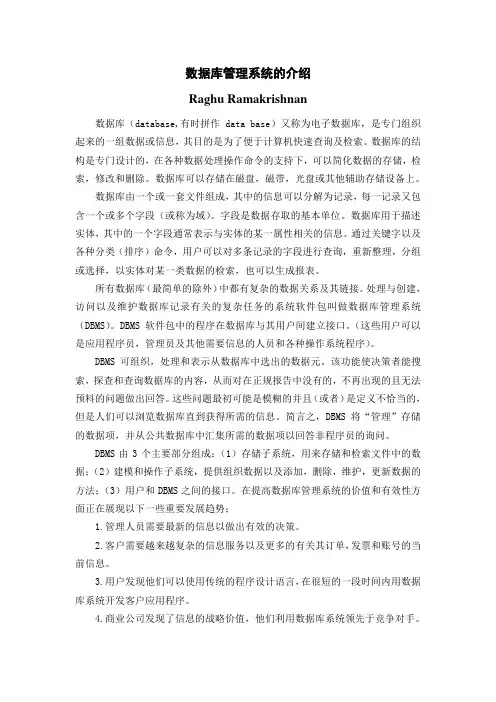
数据库管理系统的介绍Raghu Ramakrishnan数据库(database,有时拼作data base)又称为电子数据库,是专门组织起来的一组数据或信息,其目的是为了便于计算机快速查询及检索。
数据库的结构是专门设计的,在各种数据处理操作命令的支持下,可以简化数据的存储,检索,修改和删除。
数据库可以存储在磁盘,磁带,光盘或其他辅助存储设备上。
数据库由一个或一套文件组成,其中的信息可以分解为记录,每一记录又包含一个或多个字段(或称为域)。
字段是数据存取的基本单位。
数据库用于描述实体,其中的一个字段通常表示与实体的某一属性相关的信息。
通过关键字以及各种分类(排序)命令,用户可以对多条记录的字段进行查询,重新整理,分组或选择,以实体对某一类数据的检索,也可以生成报表。
所有数据库(最简单的除外)中都有复杂的数据关系及其链接。
处理与创建,访问以及维护数据库记录有关的复杂任务的系统软件包叫做数据库管理系统(DBMS)。
DBMS软件包中的程序在数据库与其用户间建立接口。
(这些用户可以是应用程序员,管理员及其他需要信息的人员和各种操作系统程序)。
DBMS可组织,处理和表示从数据库中选出的数据元。
该功能使决策者能搜索,探查和查询数据库的内容,从而对在正规报告中没有的,不再出现的且无法预料的问题做出回答。
这些问题最初可能是模糊的并且(或者)是定义不恰当的,但是人们可以浏览数据库直到获得所需的信息。
简言之,DBMS将“管理”存储的数据项,并从公共数据库中汇集所需的数据项以回答非程序员的询问。
DBMS由3个主要部分组成:(1)存储子系统,用来存储和检索文件中的数据;(2)建模和操作子系统,提供组织数据以及添加,删除,维护,更新数据的方法;(3)用户和DBMS之间的接口。
在提高数据库管理系统的价值和有效性方面正在展现以下一些重要发展趋势;1.管理人员需要最新的信息以做出有效的决策。
2.客户需要越来越复杂的信息服务以及更多的有关其订单,发票和账号的当前信息。
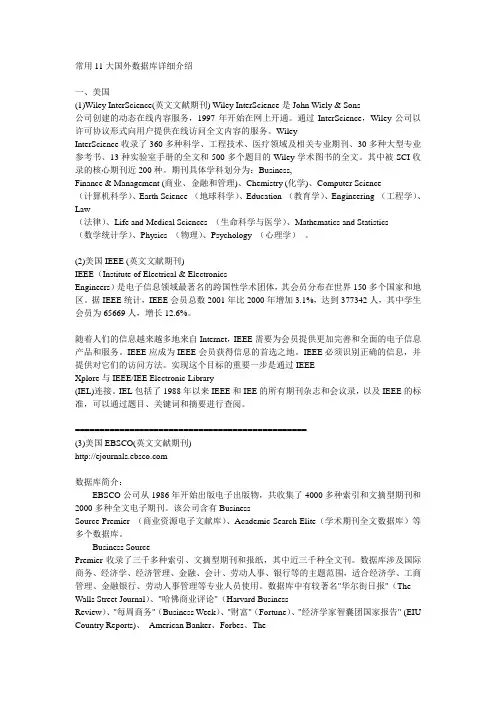
常用11大国外数据库详细介绍一、美国(1)Wiley InterScience(英文文献期刊) Wiley InterScience是John Wiely & Sons公司创建的动态在线内容服务,1997年开始在网上开通。
通过InterScience,Wiley公司以许可协议形式向用户提供在线访问全文内容的服务。
WileyInterScience收录了360多种科学、工程技术、医疗领域及相关专业期刊、30多种大型专业参考书、13种实验室手册的全文和500多个题目的Wiley学术图书的全文。
其中被SCI收录的核心期刊近200种。
期刊具体学科划分为:Business,Finance & Management (商业、金融和管理)、Chemistry (化学)、Computer Science(计算机科学)、Earth Science (地球科学)、Education (教育学)、Engineering (工程学)、Law(法律)、Life and Medical Sciences (生命科学与医学)、Mathematics and Statistics(数学统计学)、Physics (物理)、Psychology (心理学)。
(2)美国IEEE (英文文献期刊)IEEE(Institute of Electrical & ElectronicsEngineers)是电子信息领域最著名的跨国性学术团体,其会员分布在世界150多个国家和地区。
据IEEE统计,IEEE会员总数2001年比2000年增加3.1%,达到377342人,其中学生会员为65669人,增长12.6%。
随着人们的信息越来越多地来自Internet,IEEE需要为会员提供更加完善和全面的电子信息产品和服务。
IEEE应成为IEEE会员获得信息的首选之地。
IEEE必须识别正确的信息,并提供对它们的访问方法。
实现这个目标的重要一步是通过IEEEXplore与IEEE/IEE Electronic Library(IEL)连接。


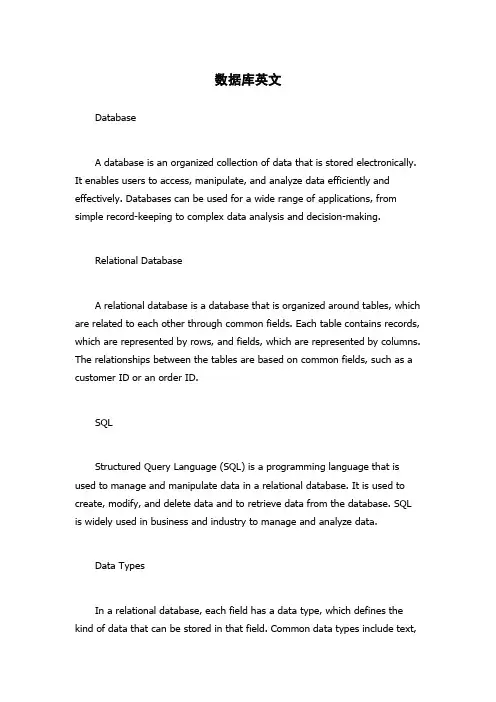
数据库英文DatabaseA database is an organized collection of data that is stored electronically. It enables users to access, manipulate, and analyze data efficiently and effectively. Databases can be used for a wide range of applications, from simple record-keeping to complex data analysis and decision-making.Relational DatabaseA relational database is a database that is organized around tables, which are related to each other through common fields. Each table contains records, which are represented by rows, and fields, which are represented by columns. The relationships between the tables are based on common fields, such as a customer ID or an order ID.SQLStructured Query Language (SQL) is a programming language that is used to manage and manipulate data in a relational database. It is used to create, modify, and delete data and to retrieve data from the database. SQL is widely used in business and industry to manage and analyze data.Data TypesIn a relational database, each field has a data type, which defines the kind of data that can be stored in that field. Common data types include text,numeric, date/time, and Boolean. Other data types, such as binary data or images, may also be used in some databases.Primary KeyA primary key is a field or set of fields in a relational database that uniquely identifies each record in a table. The primary key is used to enforce data integrity, ensuring that each record is unique and that records can be related properly between tables.Foreign KeyA foreign key is a field or set of fields in a table that refers to the primary key of another table. The foreign key is used to establish relationships between tables and to maintain data integrity by enforcing referential integrity constraints.ERDAn entity-relationship diagram (ERD) is a graphical representation of the tables and relationships in a relational database. It is used to model the data and to design the database schema.NormalizationNormalization is the process of organizing data in a database to reduce redundancy and improve data integrity. It involves breaking down tables into smaller, more specific tables and establishing relationships between them toeliminate duplicate data and ensure that data is consistent across the database.IndexesIndexes are used to improve the performance of queries in a database by providing faster access to data. An index is a data structure that is created on one or more fields in a table, allowing the database to quickly locate records that match certain criteria.TriggersTriggers are automated procedures that are executed in response to certain database events, such as the insertion, deletion, or modification of data. Triggers can be used to enforce business rules or to automate certain database tasks.TransactionsA transaction is a sequence of database operations that must be executed as a single, atomic unit. Transactions are used to ensure data integrity and to provide a consistent view of the database to all users.Backup and RecoveryBackup and recovery are critical components of database management. Regular database backups are essential for protecting data against loss orcorruption, while recovery procedures are used to restore data in the event of a disaster or other catastrophic event.Concurrency ControlConcurrency control is the process of managing simultaneous access to a database by multiple users or applications. It ensures that transactions are executed in a correct and consistent manner, while also maintaining data integrity and preventing conflicts or errors.。


英文数据库AABI/INFORM Complete ProQuest 公司出版,是欧美大学普遍使用的著名商业及经济管理期刊论文全文数据库。
Access World News 世界各国报纸全文库,全球最大与增长最快的报纸数据库,具浏览报纸功能,时效性强,每天更新,可以看到当日大部分报纸,内容十分广泛。
ACM Digital Library收录了美国计算机协会(Association for Computing Machinery)的各种电子期刊、会议录、快报等文献AGRICOLA农业参考文献数据库,涉及美国农业和生命科学等领域,提供了1970年至今的重要农业信息。
AIAA美国航空航天学会会议论文及期刊全文数据库,世界第一的航空航天和宇宙科学文献来源。
American Chemical Socitey 美国化学学会全文期刊数据库American Mathematics Society 美国数学学会数据库,世界上最权威的数学学术团体,数据库内容涉及数学及数学在统计学、工程学、物理学、经济学、生物学、运筹学、计算机科学中的应用等American Physical Society (APS) 美国物理学会数据库,为用户提供期刊的在线阅读。
Annual Reviews 为全世界的科学团体服务,提供由著名科学家撰写的评论。
Annual Reviews 分生物医学、物理学和社会科学三个主题,共出版29种期刊。
ASCE The American Society of Civil Engineers美国土木工程师协会数据库ASME Technical Journal 美国机械工程师学会数据库。
美国机械工程师学会,主持着世界上最大的技术出版之一,制定各种工业和制造业行业标准。
由于工程领域各学科间交叉性不断增长,ASME出版物也相应提供了跨学科前沿科技的资讯。
BBeilstein/Gmelin crossfire 以电子方式提供包含可供检索的化学结构和化学反应、相关的化学和物理性质,以及详细的药理学和生态学数据在内的最全面的信息资源。
Engineering Village-Compendex数据库使用指南一、数据库简介 (2)二、数据库检索指南 (2)1. 快速检索(Quick Search) (2)2. 专家检索(Expert Search) (3)3. 主题词表检索 (4)三、EI Compendex数据库检索技术 (5)1. 检索字段 (5)2. 检索算符 (5)四、EI Compendex数据库检索结果处理 (6)五、EI Compendex个性化服务 (7)六、其他数据库 (8)一、数据库简介Engineering Village-Compendex是美国《工程索引》(EI)的网络版,是目前全球最全面的工程索引二次文献数据库,包含选自5000多种工程类期刊、会议论文集和技术报告的超过7000000篇论文的参考文献和摘要。
数据库涵盖工程和应用科学领域的各学科,涉及核技术、生物工程、交通运输、化学和工艺工程、照明和光学技术、农业工程和食品技术、计算机和数据处理、应用物理、电子和通信、控制工程、土木工程、机械工程、材料工程、石油、宇航、汽车工程以及这些领域的子学科与其他主要的工程领域。
Compendex数据库每周更新数据,每年增加大约250000条新记录,以确保用户可跟踪其所在领域的最新进展。
文种:英文类型:文摘收录年限:1969年至今二、数据库检索指南Engineering Village-Compendex提供3种检索方式:快速检索(Quick Search)、专家检索(Expert Search)和主题词表检索(Thesaurus Search)。
1. 快速检索(Quick Search)快速检索方式下可以选择检索字段,进行三个字段间的逻辑运算,具有文献类型限制、文献内容限制、文献语言限制、文献出版时间限制和检索结果排序的功能。
(1)Select Database选择数据库根据您的需要,选择在一个或多个数据库中进行检索(目前只购买Compendex数据库)。